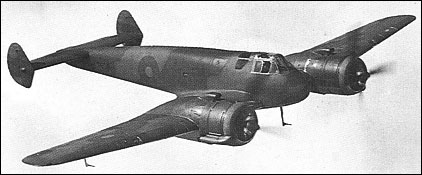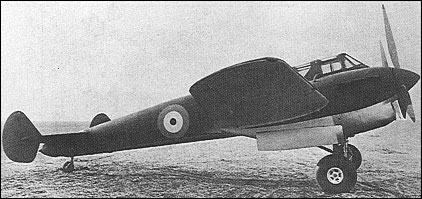|
| Designed by W G Carter to meet the demands of Specification
F.9/37 calling for a twin-engined single-seater,
this Gloster fighter was of all-metal stressed skin construction.
It was intended to carry a fuselage-mounted
armament of two 20mm Hispano cannon and four
7.7mm Browning machine guns. Two prototypes
were ordered, the first of these, powered by two 1050hp Bristol Taurus T-S(a) 14-cylinder radials, being
flown on 3 April 1939. The aircraft attained a maximum
speed of 579km/h at 4575m, but
was badly damaged in a landing accident early in its
flight test programme. When testing was resumed in
April 1940, it had been re-engined with 900hp Taurus
T-S(a) Ills with the result that performance suffered,
maximum attainable speed in level flight being reduced
to 534km/h at 4630m. The
second prototype, meanwhile, had been completed
with 885hp Rolls-Royce Peregrine liquid-cooled
engines, flying for the first time on 22 February 1940,
and attaining a maximum speed of 531km/h
during subsequent flight testing. Although the handling
characteristics of Gloster's F.9/37 contender were
considered highly satisfactory and performance with
the original engines had proved spectacular, no production
was ordered.
| ENGINE | 2 x Bristol Taurus T-S(a), 1050hp |
| WEIGHTS |
| Take-off weight | 5269 kg | 11616 lb |
| Empty weight | 4004 kg | 8827 lb |
| DIMENSIONS |
| Wingspan | 15.24 m | 50 ft 0 in |
| Length | 11.27 m | 37 ft 0 in |
| Height | 3.53 m | 12 ft 7 in |
| Wing area | 35.85 m2 | 385.89 sq ft |
| PERFORMANCE |
| Max. speed | 579 km/h | 360 mph |
 | A three-view drawing (1673 x 1183) |
| Angela, 20.06.2011 11:54 The prototype performance figures indicated the potential for a very promising heavy fighter which with further development could have served throughout WW2. reply |
| Barry, 06.01.2011 17:51 Perhaps this plane did not "fit", but a plane of simlar design if not larger overall (and agreed slower) went on to some success in the shape of the Beaufighter. Just for the record it was only the earlier model Mosquitoes that had trouble with warmer climes, later models had the adhesive (or Pritt as noted elsewhere) changed and proved a lot more successful. reply | | paul scott, e-mail, 20.08.2009 18:05 Ha ha, like that comment, Art Deco, or had no gun like the RAF version of the Eurofighter Typhoon, no doubt! I suppose it 'may' have meant the Mosquito would've been shelved, though that was more multi-role, or that the F-9 would've at least been overshadowed had the mossie entered service, still, it might not have broken up like the mossie in the far east, being metal and not stuck together with 'pritt'! reply | | Art Deco, 15.07.2009 18:50 Definitely political. If it was fitted with a Boulton-Paul 4-gun turret instead of forward firing guns ( in the most unusual location ) it would have won contracts and priorities. reply | |
| | Johned, e-mail, 14.07.2009 11:40 Appears to be yet another fine British design wasted. Why was not a production contract forthcoming - another instance of Ministry lack of foresight perhaps? The prototype performance figures indicated the potential for a very promising heavy fighter which with further development could have served throughout WW2. reply |
|
Do you have any comments?
|
| 
COMPANY
PROFILE
All the World's Rotorcraft
|









When the Japanese entered the war, Australia had no fighters. When Kittyhawks were flown up to Darwin, some were lost in bad weather. Perhaps instead of developing the Woomera, CAC should have built the Gloster with Twin Wasps and a navigator. Problem solved.
reply